Accessibility
Accessibility in the sense considered here refers to the design of products, devices, services, or environments so as to be usable by people with disabilities.[1] The concept of accessible design and practice of accessible development ensures both "direct access" (i.e. unassisted) and "indirect access" meaning compatibility with a person's assistive technology[2] (for example, computer screen readers).
| Disability |
|---|
|
Theory and models |
|
Therapy |
|
Societal implications
|
|
Disabled sports |
|
Accessibility can be viewed as the "ability to access" and benefit from some system or entity. The concept focuses on enabling access for people with disabilities, or special needs, or enabling access through the use of assistive technology; however, research and development in accessibility brings benefits to everyone.[3][4][5][6][7]
Accessibility is not to be confused with usability, which is the extent to which a product (such as a device, service, or environment) can be used by specified users to achieve specified goals with effectiveness, efficiency and satisfaction in a specified context of use.[8]
Accessibility is strongly related to universal design which is the process of creating products that are usable by people with the widest possible range of abilities, operating within the widest possible range of situations.[9] This is about making things accessible to all people (whether they have a disability or not).
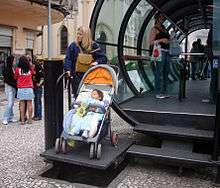
Legislation
The disability rights movement advocates equal access to social, political, and economic life which includes not only physical access but access to the same tools, services, organizations and facilities as non-disabled people (e.g., museums[10][11]). Article 9 of the United Nations Convention on the Rights of Persons with Disabilities commits signatories to provide for full accessibility in their countries.[12]
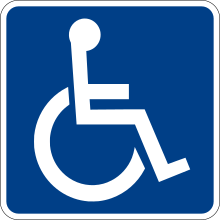
While it is often used to describe facilities or amenities to assist people with handicap impaired mobility, through the provision of facilities like wheelchair ramps, the term can extend include other types of disability. Accessible facilities[13] therefore extend to areas such as Braille signage, elevators, audio signals at pedestrian crossings, walkway contours, website design and reading accessibility.
Government mandates including Section 508, WCAG,[14] DDA are all enforcing practices to standardize accessibility testing engineering in product development.
Accessibility modifications may be required to enable persons with disabilities to gain access to education, employment, transportation, housing, recreation, or even simply to exercise their right to vote.
National legislation
Various countries have legislation requiring physical accessibility which are (in order of enactment):
- In the US, under the Americans with Disabilities Act of 1990,[15] new public and private business construction generally must be accessible. Existing private businesses are required to increase the accessibility of their facilities when making any other renovations in proportion to the cost of the other renovations. The United States Access Board[16] is "A Federal Agency Committed to Accessible Design for People with Disabilities." The Job Accommodation Network discusses accommodations for people with disabilities in the workplace.[17] Many states in the US have their own disability laws.
- In Australia, the Disability Discrimination Act 1992 has numerous provisions for accessibility.[18]
- In South Africa the Promotion of Equality and Prevention of Unfair Discrimination Act 2000 has numerous provisions for accessibility.[19]
- In the UK, the Equality Act 2010 has numerous provisions for accessibility.[20]
- In Sri Lanka, the Supreme Court, on 27 April 2011 gave a landmark order to boost the inherent right of disabled persons to have unhindered access to public buildings and facilities.[21]
- In Norway, the Discrimination and Accessibility Act Diskriminerings- og tilgjengelighetsloven defines lack of accessibility as discrimination and obliges public authorities to implement universal design in their areas. The Act refers to issue-specific legislation regarding accessibility in e.g. ICT, the built environment, transport and education.[22]
- In Brazil, the Brazilian law on the inclusion of people with disabilities has numerous provisions for accessibility.[23]
- In Canada, relevant federal legislation includes the Canadian Human Rights Act, the Employment Equity Act, the Canadian Labour Code, and the Accessible Canada Act (Bill-C81) which made Royal Assent on June 21, 2019.[24]
Legislation may also be enacted on a state, provincial or local level. In Ontario, Canada, the Ontarians with Disabilities Act of 2001 is meant to "improve the identification, removal and prevention of barriers faced by persons with disabilities.[25].."
The European Union (EU), which has signed the United Nations' Convention on the Rights of Persons with Disabilities, also has adopted a European Disability Strategy for 2010-20. The Strategy includes the following goals, among others:[26]
- devising policies for inclusive, high-quality education;
- ensuring the European Platform Against Poverty includes a special focus on people with disabilities (the forum brings together experts who share best practices and experience);
- working towards the recognition of disability cards throughout the EU to ensure equal treatment when working, living or travelling in the bloc
- developing accessibility standards for voting premises and campaign material;
- taking the rights of people with disabilities into account in external development programmes and for EU candidate countries.
A European Accessibility Act was proposed in late 2012.[27] This Act would establish standards within member countries for accessible products, services, and public buildings. The harmonization of accessibility standards within the EU "would facilitate the social integration of persons with disabilities and the elderly and their mobility across member states, thereby also fostering the free movement principle".[28]
Assistive technology and adaptive technology
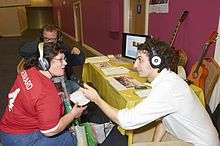
Assistive technology is the creation of a new device that assists a person in completing a task that would otherwise be impossible. Some examples include new computer software programs like screen readers, and inventions such as assistive listening devices, including hearing aids, and traffic lights with a standard color code that enables colorblind individuals to understand the correct signal.
Adaptive technology is the modification, or adaptation, of existing devices, methods, or the creation of new uses for existing devices, to enable a person to complete a task.[29] Examples include the use of remote controls, and the autocomplete (word completion)[30] feature in computer word processing programs, which both help individuals with mobility impairments to complete tasks. Adaptations to wheelchair tires are another example; widening the tires enables wheelchair users to move over soft surfaces, such as deep snow on ski hills, and sandy beaches.
Assistive technology and adaptive technology have a key role in developing the means for people with disabilities to live more independently, and to more fully participate in mainstream society. In order to have access to assistive or adaptive technology, however, educating the public and even legislating requirements to incorporate this technology have been necessary.
Employment
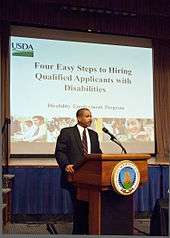
Accessibility of employment covers a wide range of issues, from skills training, to occupational therapy,[31] finding employment, and retaining employment.
Employment rates for workers with disabilities are lower than for the general workforce. Workers in Western countries fare relatively well, having access to more services and training as well as legal protections against employment discrimination. Despite this, in the United States the 2012 unemployment rate for workers with disabilities was 12.9%, while it was 7.3% for workers without disabilities.[32] More than half of workers with disabilities (52%) earned less than $25,000 in the previous year, compared with just 38% of workers with no disabilities. This translates into an earnings gap where individuals with disabilities earn about 25 percent less of what workers without disabilities earn. Among occupations with 100,000 or more people, dishwashers had the highest disability rate (14.3%), followed by refuse and recyclable material collectors (12.7%), personal care aides (11.9%), and janitors and building cleaners (11.8%). The rates for refuse and recyclable material collectors, personal care aides, and janitors and building cleaners were not statistically different from one another.[33]
Surveys of non-Western countries are limited, but the available statistics also indicate fewer jobs being filled by workers with disabilities. In India, a large 1999 survey found that "of the 'top 100 multinational companies' in the country [...] the employment rate of persons with disabilities in the private sector was a mere 0.28%, 0.05% in multinational companies and only 0.58% in the top 100 IT companies in the country".[34] India, like much of the world, has large sections of the economy that are without strong regulation or social protections, such as the informal economy.[35] Other factors have been cited as contributing to the high unemployment rate, such as public service regulations. Although employment for workers with disabilities is higher in the public sector due to hiring programs targeting persons with disabilities, regulations currently restrict types of work available to persons with disabilities: "Disability-specific employment reservations are limited to the public sector and a large number of the reserved positions continue to be vacant despite nearly two decades of enactment of the PWD Act".[34]
Expenses related to adaptive or assistive technology required to participate in the workforce may be tax deductible expenses for individuals with a medical practitioner's prescription in some jurisdictions.
Disability Management
Disability Management (DM) is a specialized area of human resources, to support efforts by employers to better integrate and retain workers with disabilities. Some workplaces have policies in place to provide "reasonable accommodation" for employees with disabilities, however, many do not. In some jurisdictions, employers may have legal requirements to end discrimination against persons with disabilities.
It has been noted by researchers that where accommodations are in place for employees with disabilities, these frequently apply to individuals with "pre-determined or apparent disabilities as determined by national social protection or Equality Authorities",[36] which include persons with pre-existing conditions who receive an official disability designation. One of the biggest challenges for employers is in developing policies and practises to manage employees who develop disabilities during the course of employment. Even where these exist, they tend to focus on workplace injuries, overlooking job retention challenges faced by employees who acquire a non-occupation injury or illness. Protecting employability is a factor that can help close the unemployment gap for persons with disabilities.[36]
Meeting and conference access
Meetings and conferences should consider the needs of all of their participants. Checklists such as this may make it easier to identify specific needs:[37]
- Wheelchair accessible transportation - see Persons with reduced mobility
- Reserved parking
- Barrier-free meeting rooms / restrooms / podium/speaker's platform
- ADA Compliant Ramp Access to businesses and public places[38]
- Accessible lodging
- Hearing access
- Advance copies of papers
- An assistive listening system
- Sign language interpreters
- A quiet place to gather for social conversation (a quieter space that is still visible to others should be reserved at social events or dinners so that people who are hard of hearing may go there to talk with their colleagues.)
- TTY access or Internet-based TRS
- full access
- Large print/braille copies of the program and papers
- A student volunteer to guide and describe the artwork, computer work, etc.
- A tech to help with assistive devices and screen readers (e.g., JAWS)
- Gloves to touch three dimensional work (where permissible)
- Other issues
- Notification if social events include flashing lights and noises (these can cause seizures, so either avoid them or announce them ahead of time).
- Notices asking participants to refrain from allergy-producing problems (e.g., perfumes)
- Inform food providers of food allergies (e.g., peanuts, shellfish, etc.)
- Referral information for local personal care attendant agencies
- Referral information for veterinarian care for service animals
- Access to a place to rest during the day (if the conference venue is far from the lodgings)
Planning for accessibility
Accessibility based planning is a spatial planning methodology that centralises goals of people and businesses and defines accessibility policy as enhancing people and business opportunities.
Traditionally, urban transportation planning has mainly focused on the efficiency of the transport system itself and is often responding to plans made by spatial planners. Such an approach neglects the influence of interventions in the transport system on broader and often conflicting economic, social and environmental goals. Accessibility based planning defines accessibility as the amount of services and jobs people can access within a certain travel time, considering one or more modes of transport such as walking, cycling, driving or public transport. Using this definition accessibility does not only relate to the qualities of the transport system (e.g. travel speed, time or costs), but also to the qualities of the land use system (e.g. densities and mixes of opportunities). It thus provides planners with the possibility to understand interdependencies between transport and land use development. Accessibility planning opens the floor to a more normative approach to transportation planning involving different actors.[39] For politicians, citizens and firms it might be easier to discuss the quality of access to education, services and markets than it is to discuss the inefficiencies of the transport system itself. Accessibility is also defined as "the potential for interaction".
Accessibility instruments
Generally since the 1960s, accessibility instruments have been developed for a multitude of contexts and scopes. These instruments have their focus on origins and on destinations, they measure access through time, distance or cost and focus on different modes of transportation and geographical scales. Accessibility instruments are thus able to show what are the best accessible places or opportunities within a city or region, considering one or more specific modes of transportation, timeslots and target groups. In addition to this, the maps, which are produced as the instrument output, are considered as considerably useful when assessing the effects of new developments in a city. The first ever first large scale compendium of accessibility instruments was developed in 2012, under the framework of Cost Action TU1002, and is available.[40]
Potentials of accessibility in planning practice
Despite the high potential of accessibility in integrating the different components of urban planning, such as land use and transportation and the large number of accessibility instruments available in the research literature, the latter are not widely used to support urban planning practices.[41] By keeping the accessibility language out of the practice level, older paradigms resist the more informed and people-centred approaches. Focusing on the link between research and practice, the Cost Action TU1002 [42] seeks to find out why accessibility instruments are not more often used in urban planning practice and reflects on how to reduce such implementation gap in planning practice. The existence of accessibility instruments is fairly acknowledged, but practitioners do not appear to have found them useful or usable enough for addressing the tasks of sustainable urban management. This Cost Action TU1002 is bringing together developers of accessibility instruments all over Europe and Australia to work with land use and transportation planning practitioners to explore how these instruments can play a more supportive role in enhancing accessibility in European cities and beyond. So far, 24 Accessibility Instruments have been gathered, analysed and described so as to understand in detail their characteristics, planning issues addressed and specific purposes, according to the developers’ view. In turn, these instruments are being tested in a series of workshops with multidisciplinary teams of practitioners around Europe addressing the issue of usability from the practitioners’ viewpoint. In doing so, it is expected that the additional knowledge on the potential of accessibility instruments for urban planning practice will have beneficial impacts on urban quality and decision making on urban land use patterns.
Transportation
Providing mobility to people with disabilities includes changes for public facilities like gently sloping paths of travel for people with wheelchairs and difficulty walking up stairs, or audio announcements for the blind; dedicated services like paratransit; and adaptations to personal vehicles.
Adapted automobiles for persons with disabilities

Automobile accessibility also refers to ease of use by disabled people. Automobiles, whether a car or a van, can be adapted for a range of physical disabilities. Foot pedals can be raised, or replaced with hand-controlled devices. Wheelchair hoists, lifts or ramps may be customized according to the needs of the driver. Ergonomic adaptations, such as a lumbar support cushion, may also be needed.[43]
Generally, the more limiting the disability, the more expensive the adaptation needed for the vehicle. Financial assistance is available through some organizations, such as Motability in the United Kingdom, which requires a contribution by the prospective vehicle owner. Motability makes vehicles available for purchase or lease.[44]
When an employee with a disability requires an adapted car for work use, the employee does not have to pay for a "reasonable adjustment" in the United Kingdom; if the employer is unable to pay the cost, assistance is offered by government programs.[45]
Low floor
A significant development in transportation, and public transport in particular, to achieve accessibility, is the move to "low-floor" vehicles. In a low-floor vehicle, access to part or all of the passenger cabin is unobstructed from one or more entrances by the presence of steps, enabling easier access for the infirm or people with push chairs. A further aspect may be that the entrance and corridors are wide enough to accommodate a wheelchair. Low-floor vehicles have been developed for buses, trolleybuses and trams.
A low floor in the vehicular sense is normally combined in a conceptual meaning with normal pedestrian access from a standard kerb (curb) height. However, the accessibility of a low-floor vehicle can also be utilised from slightly raising portions of kerb at bus stops, or through use of level boarding bus rapid transit stations or tram stops.[46] The combination of access from a kerb was the technological development of the 1990s, as step-free interior layouts for buses had existed in some cases for decades, with entrance steps being introduced as chassis designs and overall height regulations changed.
Low-floor buses may also be designed with special height adjustment controls that permit a stationary bus to temporarily lower itself to ground level, permitting wheelchair access. This is referred to as a kneeling bus.
At rapid transit systems, vehicles generally have floors in the same height as the platforms but the stations are often underground or elevated, so accessibility there isn't a question of providing low-floor vehicles, but providing a step-free access from street level to the platforms (generally by elevators, which are somewhat restricted to disabled passengers only, so that the step-free access isn't obstructed by healthy people taking advantage).
Accessibility planning for transportation in the United Kingdom
In the United Kingdom, local transport authorities are responsible for checking that all people who live within their area can access essential opportunities and services, and where gaps in provision are identified the local authorities are responsible for organizing changes to make new connections. These requirements are defined in the UK Community Planning Acts legislation[47] and more detailed guidance has been issued by the Department for Transport for each local authority. This includes the requirement to produce an Accessibility Plan under Community Planning legislation and to incorporate this within their Local Transport Plan.[48] An Accessibility Plan sets out how each local authority plans to improve access to employment, learning, health care, food shops and other services of local importance, particularly for disadvantaged groups and areas. Accessibility targets are defined in the accessibility plans, these are often the distance or time to access services by different modes of transport including walking, cycling and public transport.
Accessibility Planning was introduced as a result of the report "Making the Connections: Final Report on Transport and Social Exclusion".[49] This report was the result of research carried out by the Social Exclusion Unit. The United Kingdom also has a "code of practice" for making train and stations accessible: "Accessible Train and Station Design for Disabled People: A Code of Practice".[50] This code of practice was first published in 2002 with the objective of compliance to Section 71B of the Railways Act 1993,[51] and revised after a public consultation period in 2008.
Making public services fully accessible to the public has led to some technological innovations. Public announcement systems using audio induction loop technology can broadcast announcements directly into the hearing aid of anyone with a hearing impairment, making them useful in such public places as auditoriums and train stations. Australia's government has supported the creation of the National Public Toilet Map, to enable users to locate public toilet facilities throughout the country.[52] GPS is also included as a feature. The service assists people with continence issues, which is estimated to be up to 18% of the population, including the elderly and families with young children.
Accessibility in urban design
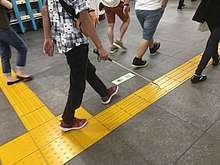
Accessibility modifications to conventional urban environments has become common in recent decades. The use of a curb cut, or kassel kerb, to enable wheelchair or walker movement between sidewalk and street level is found in most major cities of wealthy countries. The creation of priority parking spaces and of disabled parking permits has made them a standard feature of urban environments. Features that assist people with visual impairments include braille signs and tactile paving to allow a user with a cane to easily identify stairways, train platforms, and similar areas that could pose a physical danger to anyone who has a visual impairment.
Urban design features that may appear to be simple conveniences for persons without disabilities are often essential to anyone who has a disability. The loss of these features presents a significant barrier. For example, sometimes a lack of prompt snow-clearing on sidewalks of major Canadian city streets means that wheelchair and walker users cannot reach pedestrian crossing buttons on crosswalk posts, due to snow bank accumulation around the posts, making the crossing buttons inaccessible. Public services must take into account the need to maintain accessibility features in the urban environment.
Housing
Most existing and new housing, even in the wealthiest nations, lack basic accessibility features unless the designated, immediate occupant of a home currently has a disability. However, there are some initiatives to change typical residential practices so that new homes incorporate basic access features such as zero-step entries and door widths adequate for wheelchairs to pass through. Occupational Therapists are a professional group skilled in the assessment and making of recommendations to improve access to homes.[53] They are involved in both the adaptation of existing housing to improve accessibility,[54] and in the design of future housing.[55]
The broad concept of Universal design is relevant to housing, as it is to all aspects of the built environment. Furthermore, a Visitability movement[56] begun by grass roots disability advocates in the 1980s focuses specifically on changing construction practices in new housing. This movement, a network of interested people working in their locales, works on educating, passing laws, and spurring voluntary home access initiatives with the intention that basic access become a routine part of new home construction.
Accessibility and 'ageing in place'
Accessibility in the design of housing and household devices has become more prominent in recent decades due to a rapidly ageing population in developed countries.[57] Ageing seniors may wish to continue living independently, but the ageing process naturally increases the disabilities that a senior citizen will experience. A growing trend is the desire for many senior citizens to 'age in place', living as independently as possible for as long as possible. Accessibility modifications that allow ageing in place are becoming more common. Housing may even be designed to incorporate accessibility modifications that can be made throughout the life cycle of the residents.
Voting
Under the Convention on the Rights of Persons with Disabilities, states parties are bound to assure accessible elections, voting, and voting procedures. In 2018, the United Nations Committee on the Rights of Persons with Disabilities issued an opinion that all polling stations should be fully accessible. At the European Court of Human Rights, there are currently two ongoing cases about the accessibility of polling places and voting procedures. They were brought against Slovenia by two voters and the Slovenian Disability Rights Association.[58] As of January 2020, the cases, called Toplak v. Slovenia and Mrak v. Slovenia, are ongoing.[59] The aim of the court procedure is to make accessible all polling places in Europe.[60]
Disability, information technology (IT) and telecommunications
Advances in information technology and telecommunications have represented a leap forward for accessibility. Access to the technology is restricted to those who can afford it, but it has become more widespread in Western countries in recent years. For those who use it, it provides the ability to access information and services by minimizing the barriers of distance and cost as well as the accessibility and usability of the interface. In many countries this has led to initiatives, laws and/or regulations that aim toward providing universal access to the internet and to phone systems at reasonable cost to citizens.[61]
A major advantage of advanced technology is its flexibility. Some technologies can be used at home, in the workplace, and in school, expanding the ability of the user to participate in various spheres of daily life. Augmentative and alternative communication technology is one such area of IT progress. It includes inventions such as speech-generating devices, teletypewriter devices, adaptive pointing devices to replace computer mouse devices, and many others. They can be adapted to create accessibility to a range of tasks, and may be suitable for different kinds of disability.
The following impairments are some of the disabilities that affect communications and technology access, as well as many other life activities:
- communication disorders;[62]
- hearing impairments;[63]
- visual impairments;[64]
- mobility impairments;
- a learning disability or impairment in mental functioning.
Each kind of disability requires a different kind of accommodation, and this may require analysis by a medical specialist, an educational specialist or a job analysis when the impairment requires accommodation.
Examples of common assistive technologies
| Impairment | Assistive technology |
|---|---|
| Communication impairment | Blissymbols board or similar device; electronic speech synthesizer |
| Hearing impairment | earphones, headphones, headsets; real-time closed captioning; teletypewriter |
| Mobility impairment | Page-turning device; adaptive keyboards and computer mice (pointing devices such as trackballs, vertical mouse, foot mouse, or programmable pedal) |
| Physical or mental impairment, learning disability | Voice recognition software, refreshable braille display, screen reader |
| Perceptual disability, learning disability | Talking textbooks, virtual keyboard |
| Visual impairment, learning disability | Modified monitor interface, magnification devices; reading service, e-text |
| Visual impairment, learning disability | Braille note-taker; Braille printer; screen magnifiers; optical scanner |
Mobility impairments
One of the first areas where information technology improved the quality of life for disabled individuals is the voice operated wheelchair. Quadriplegics have the most profound disability, and the voice operated wheelchair technology was first developed in 1977 to provide increased mobility. The original version replaced the joystick system with a module that recognized 8 commands. Many other technology accommodation improvements have evolved from this initial development.[66]
Missing arms and fingers interferes with the use of a keyboard and pointing device (mouse). This can be one of the most devastating types of handicap, and technology has made great improvements in this area during the last 20 years. Speech recognition devices and software can improve technology access.
Communication (including speech) impairments
A communication disorder interferes with the ability to produce clearly understandable speech. There can be many different causes, such as nerve degeneration, muscle degeneration, stroke, and vocal cord injury. The modern method to deal with speaking disabilities has been to provide a text interface for a speech synthesizer for complete vocal disability. This can be a great improvement for people that have been limited to the use of a throat vibrator to produce speech since the 1960s.
Hearing impairment
An individual satisfies the definition of hearing disabled when hearing loss is about 30 dB for a single frequency, but this is not always perceptible as a handicap.[67] For example, loss of sensitivity in one ear interferes with sound localization (directional hearing), which can interfere with communication in a crowd. This is often recognized when certain words are confused during normal conversation. This can interfere with voice-only interfaces, like automated customer service telephone systems, because it is sometimes difficult to increase the volume and repeat the message.
Mild to moderate hearing loss may be accommodated with a hearing aid that amplifies ambient sounds. Portable devices with speed recognition that can produce text can reduce problems associated with understanding conversation. This kind of hearing loss is relatively common, and this often grows worse with age.
The modern method to deal with profound hearing disability is the Internet using email or word processing applications. The telecommunications device for the deaf (TDD) became available in the form of the teletype (TTY) during the 1960s. These devices consist of a keyboard, display and modem that connects two or more of these devices using a dedicated wire or plain old telephone service.
Visual impairments
A wide range of technology products are available to deal with visual impairment. This includes screen magnification for monitors, screen-reading technology for computers and small screen devices, mouse-over speech synthesis browsing, braille displays, braille printers, braille cameras, voice-operated phones, and tablets.
One emerging product that will make ordinary computer displays available for the blind is the refreshable tactile display, which is very different from a conventional braille display. This provides a raised surface corresponding to the bright and dim spots on a conventional display. An example is the Touch Sight Camera for the Blind.
Speech Synthesis Markup Language (V1.0 Released 7 September 2004[68]) and Speech Recognition Grammar Specification (V1.0 released 16 March 2004[69]) are relatively recent technologies intended to standardize communication interfaces using Augmented BNF Form and XML Form. These technologies assist visual impairments and physical impairment by providing interactive access to web content without the need to visually observe the content. While these technologies provides access for visually impaired individuals, the primary benefactor has been automated systems that replace live human customer service representatives that handle telephone calls.
Web accessibility
International standards and guidelines
There have been a few major movements to coordinate a set of guidelines for accessibility for the web. The first and most well known is The Web Accessibility Initiative (WAI), which is part of the World Wide Web Consortium (W3C). This organization developed the Web Content Accessibility Guidelines (WCAG) 1.0 and 2.0 which explain how to make Web content accessible to everyone, including people with disabilities. Web "content" generally refers to the information in a Web page or Web application, including text, images, forms, and sounds. (More specific definitions are available in the WCAG documents.)[70]
The WCAG is separated into three levels of compliance, A, AA and AAA. Each level requires a stricter set of conformance guidelines, such as different versions of HTML (Transitional vs Strict) and other techniques that need to be incorporated into coding before accomplishing validation. Online tools allow users to submit their website and automatically run it through the WCAG guidelines and produce a report, stating whether or not they conform to each level of compliance. Adobe Dreamweaver also offers plugins which allow web developers to test these guidelines on their work from within the program.
The ISO/IEC JTC1 SC36 WG7 24751 Individualized Adaptability and Accessibility in e-learning, education and training series is freely available and made of 3 parts: Individualized Adaptability and Accessibility in e-learning, education and training, Standards inventory and Guidance on user needs mapping.
Another source of web accessibility guidance comes from the US government. In response to Section 508 of the US Rehabilitation Act, the Access Board developed standards to which U.S. federal agencies must comply in order to make their sites accessible. The U.S. General Services Administration has developed a website where one can take online training courses for free to learn about these rules.[71]
Web accessibility features
Examples of accessibility features include:
- WAI-AA compliance with the WAI's WCAG
- Semantic Web markup
- (X)HTML Validation from the W3C for the page's content
- CSS Validation from the W3C for the page's layout
- Compliance with all guidelines from Section 508 of the US Rehabilitation Act
- A high contrast version of the site for individuals with low vision, and a low contrast (yellow or blue) version of the site for individuals with dyslexia
- Alternative media for any multimedia used on the site (video, flash, audio, etc.)
- Simple and consistent navigation
- Device independent
While WCAG provides much technical information for use by web designers, coders and editors, BS 8878:2010 Web accessibility – Code of Practice[72] has been introduced, initially in the UK, to help site owners and product managers to understand the importance of accessibility. It includes advice on the business case behind accessibility, and how organisations might usefully update their policies and production processes to embed accessibility in their business-as-usual. On 28 May 2019, BS 8878 was superseded by ISO 30071-1,[73] the international Standard that built on BS 8878 and expanded it for international use.
Another useful idea is for websites to include a web accessibility statement on the site. Initially introduced in PAS 78,[74] the best practice for web accessibility statements has been updated in BS 8878[75] to emphasise the inclusion of: information on how disabled and elderly people could get a better experience of using the website by using assistive technologies or accessibility settings of browsers and operating systems (linking to "BBC My Web My Way"[76] can be useful here); information on what accessibility features the site's creators have included, and if there are any user needs which the site doesn't currently support (for example, descriptive video to allow blind people to access the information in videos more easily); and contact details for disabled people to be able to use to let the site creators know if they have any problems in using the site. While validations against WCAG, and other accessibility badges can also be included, they should be put lower down the statement, as most disabled people still do not understand these technical terms.[77]
Education and accessibility for students


Equal access to education for students with disabilities is supported in some countries by legislation. It is still challenging for some students with disabilities to fully participate in mainstream education settings, but many adaptive technologies and assistive programs are making improvements. In India, the Medical Council of India has now passed the directives to all the medical institutions to make them accessible to persons with disabilities. This happened due to a petition by Dr Satendra Singh founder of Infinite Ability.[78]
Students with a physical or mental impairment or learning disability may require note-taking assistance, which may be provided by a business offering such services, as with tutoring services. Talking books in the form of talking textbooks are available in Canadian secondary and post-secondary schools. Also, students may require adaptive technology to access computers and the Internet. These may be tax-exempt expenses in some jurisdictions with a medical prescription.
Accessibility of Assessments
It is important to ensure that the accessibility in education includes assessments. "Accessibility must be considered from the outset when designing assessments, otherwise disabled learners could be unintentionally disadvantaged."[79] Accessibility in testing or assessments entails the extent to which a test and its constituent item set eliminates barriers and permits the test-taker to demonstrate his or her knowledge of the tested content.[80]
With the passage of the No Child Left Behind Act of 2001 in the United States,[81] student accountability in essential content areas such as reading, mathematics, and science has become a major area of focus in educational reform.[82] As a result, test developers have needed to create tests to ensure all students, including those with special needs (e.g., students identified with disabilities), are given the opportunity to demonstrate the extent to which they have mastered the content measured on state assessments. Currently, states are permitted to develop two different types of tests in addition to the standard grade-level assessments to target students with special needs. First, the alternate assessment may be used to report proficiency for up to 1% of students in a state. Second, new regulations permit the use of alternate assessments based on modified academic achievement standards to report proficiency for up to 2% of students in a state.
To ensure these new tests generate results that permit valid inferences about student performance, they must be accessible to as many individuals as possible. The Test Accessibility and Modification Inventory (TAMI)[83] and its companion evaluation tool, the Accessibility Rating Matrix (ARM), were designed to facilitate the evaluation of tests and test items with a focus on enhancing their accessibility. Both instruments integrate principles of accessibility theory and were guided by research on universal design, assessment accessibility, cognitive load theory, and research on item-writing and test development. The TAMI is a non-commercial instrument that has been made available to all state assessment directors and testing companies. Assessment researchers have used the ARM to conduct accessibility reviews of state assessment items for several state departments of education.
Accessibility - mass communication process of agenda-setting
Agenda setting occurs through a cognitive process known as "accessibility".[84][85] Accessibility implies that the more frequently and prominently the news media cover an issue, the more instances of that issue become accessible in audience's memories. When respondents are asked what the most important problem facing the country is, they answer with the most accessible news issue in memory, which is typically the issue the news media focused on the most. The agenda-setting effect is not the result of receiving one or a few messages but is due to the aggregate impact of a very large number of messages, each of which has a different content but all of which deal with the same general issue.[86] Mass-media coverage in general and agenda-setting in particular also has a powerful impact on what individuals think that other people are thinking,[86][87] and hence they tend to allocate more importance to issues that have been extensively covered by mass media. This is also called schemata theory. In psychology and cognitive science, a schema (plural schemata or schemas) describes a pattern of thought or behavior that organizes categories of information and the relationships among them.
See also
- Accessible publishing
- Assistive technology
- Accessible toilet
- Accessible tourism
- CEN/CENELEC Guide 6
- Computer accessibility
- Convenience
- Universal design
- Design for All (in ICT)
- Human factors and ergonomics
- Game accessibility
- Knowbility
- National Federation of the Blind v. Target Corporation
- Occupational therapy
- Principles of Intelligent Urbanism
- Section 504 of the Rehabilitation Act
- Section 508 Amendment to the Rehabilitation Act of 1973
- Transgenerational design
- Visitability
- Walking audit
- Walter Harris Callow, inventor of wheelchair accessible bus
- Wheelchair accessible van
- Web accessibility
- Universal design for instruction
References
- Henry, Shawn Lawton; Abou-Zahra, Shadi; Brewer, Judy (2014). The Role of Accessibility in a Universal Web. Proceeding W4A '14 Proceedings of the 11th Web for All Conference Article No. 17. ISBN 978-1-4503-2651-3. Retrieved 2014-12-17.
- "What is assistive technology?". washington.edu. Archived from the original on 2019-01-19. Retrieved 2018-07-02.
- "Federal Communications Commission". FCC on Telecommunications Accessibility for the Disabled. 1999.
- Goldberg, L. (1996). "Electronic Curbcuts: Equitable Access to the Future". Getty Center for the History of Art and the Humanities and the Getty Art History Information Program, Cyberspace/Public Space: The Role of Arts and Culture in Defining a Virtual Public Sphere. Archived from the original on April 27, 1999.
- Jacobs, S. (1999). "Section 255 of the Telecommunications Act of 1996: Fueling the Creation of New Electronic Curbcuts".
- Valdes, L. (2003). "Accessibility on the Internet".
- Brewer, J. "Access to the World Wide Web: Technical and Policy Aspects". In Preiser, W.; Ostroff, E. (eds.). Universal Design Handbook (1st ed.). New York: MacGraw-Hill.
- Initiative (WAI), W3C Web Accessibility. "Accessibility, Usability, and Inclusion". Web Accessibility Initiative (WAI). Retrieved 2020-07-05.
- "The Concept of Universal Design". udeworld.com. Archived from the original on 2018-07-04. Retrieved 2018-07-02.
- Lisney, Eleanor; Bowen, Jonathan P.; Hearn, Kirsten; Zedda, Maria (2013). "Museums and Technology: Being Inclusive Helps Accessibility for All". Curator: The Museum Journal. 56 (3): 353. doi:10.1111/cura.12034.
- Norberto Rocha, Jessica; Massarani, Luisa; de Abreu, Willian; Inacio, Gustavo; Molenzani, Aline (2020). "Investigating accessibility in Latin American science museums and centers". Annals of the Brazilian Academy of Sciences. 92 (1): e20191156. doi:10.1590/0001-3765202020191156. PMID 32321029.
- "Convention on the Rights of Persons with Disabilities (CRPD) | United Nations Enable". un.org. Retrieved 2018-07-02.
- "Accessibility Tools: When is a facility considered accessible?". fs.fed.us. Retrieved 2018-07-02.
- "Section508.gov | GSA Government-wide IT Accessibility Program". section508.gov. Retrieved 2018-07-02.
- "An Overview of the Americans With Disabilities Act | ADA National Network". adata.org. Retrieved 2018-07-02.
- "Home - United States Access Board". access-board.gov. Retrieved 2018-07-02.
- "JAN - Job Accommodation Network". askjan.org. Retrieved 2018-07-02.
- AG. "Disability Discrimination Act 1992". legislation.gov.au. Retrieved 2018-07-02.
- 56231. "SOUTH AFRICA. PROMOTION OF EQUALITY AND PREVENTION OF UNFAIR DISCRIMINATION ACT, 2000". ilo.org. Retrieved 2018-07-02.CS1 maint: numeric names: authors list (link)
- "Equality Act 2010: guidance". GOV.UK. Retrieved 2018-07-02.
- Ockersz, Lynn (8 November 2009). "Landmark Supreme Court ruling – A fillip for accessibility rights of disabled". News – Page 17. Upali Newspapers – The Sunday Island. Retrieved 2010-01-26.
- "Ikke tilgjengelig:Lov om forbud mot diskriminering på grunn av nedsatt funksjonsevne (diskriminerings- og tilgjengelighetsloven) - Lovdata". lovdata.no.
- "Lei Brasileira de Inclusão da Pessoa com Deficiência (Estatuto da Pessoa com Deficiência)". planalto.gov.br.
- "Canada's first federal accessibility legislation receives Royal Assent". Employment and Social Development Canada. 21 June 2019. Retrieved 18 September 2019.
- "About the AODA – Accessibility Ontario". accessontario.com. Retrieved 2018-07-02.
- "EU disability strategy 2010-20: access and rights". European Commission. Retrieved November 12, 2012.
- "European Accessibility Act: legislative initiative to improve accessibility of goods and services in the Internal Market" (PDF). European Commission. September 2012. Retrieved 13 June 2014.
- "European Accessibility Act proposed for 2012". Eurocities. Retrieved November 12, 2012.
- "What is Adaptive Technology? // ACT Center". actcenter.missouri.edu. Retrieved 2018-07-02.
- "HTML input autocomplete Attribute". w3schools.com. Retrieved 2018-07-02.
- "What is Occupational Therapy? - AOTA". aota.org. Retrieved 2018-07-02.
- "Disability Employment Resources by Topic". U.S. Department of Labor – Office of Disability Employment Policy. Retrieved November 30, 2012.
- n/a. "Workers with a Disability Less Likely to be Employed, More Likely to Hold Jobs with Lower Earnings, Census Bureau Reports". United States Census Bureau Newsroom. Retrieved 30 April 2014.
- Arun Kumar; Deepa Sonpal; Vanmala Hiranandani (2012). "Trapped Between Ableism And Neoliberalism: Critical Reflections On Disability And Employment In India". Disability Studies Quarterly. 32 (3): N.p. Retrieved November 30, 2012.
- "Nearly two-thirds of global workforce in the 'informal' economy – UN study". UN News. 2018-04-30. Retrieved 2018-07-02.
- Geisen, Thomas; Henry George Harder (2011). Disability Management and Workplace Integration: International Research Findings. Gower Publishing. p. 165. ISBN 9781409418887.
- "Equal Access: Universal Design of Conference Exhibits and Presentations". USA: University of Washington. Retrieved 13 June 2014.
- "ADA Specifications for Wheelchair use". Retrieved 10 October 2016.
- "Planning for Sustainable Travel - Key Themes - Accessibility of Key Facilities". plan4sustainabletravel.org. Archived from the original on 2018-02-08. Retrieved 2018-07-02.
- "Accessibility Instruments". accessibilityplanning.eu.
- Angela Hull; Cecília Silva; Luca Bertolini (June 2012). Accessibility Instruments for Planning Practice (PDF). COST Office. ISBN 978-989-20-3210-8.
- "COST Action TU1002 | EDGE". tut.fi. Retrieved 2018-07-02.
- Dimond, Bridget C. (2009). Legal Aspects of Physiotherapy. John Wiley & Sons. pp. 263. ISBN 9781405176156.
- Dimond, Bridget C. (2011). Legal Aspects of Occupational Therapy. John Wiley & Sons. pp. n.p. ISBN 9781444348163.
- Disability Rights Commission (2004). Disability Discrimination Act 1995: Code of Practice; Employment and Occupation. The Stationery Office. p. 5. ISBN 9780117034198.
- "What is BRT? - Institute for Transportation and Development Policy". Institute for Transportation and Development Policy. Retrieved 2018-07-02.
- "Community planning in the devolved UK". The Knowledge Exchange Blog. 2017-01-25. Retrieved 2018-07-02.
- "Local Transport Plan | PLYMOUTH.GOV.UK". plymouth.gov.uk. Archived from the original on 2018-07-02. Retrieved 2018-07-02.
- Office of the Deputy Prime Minister – Social Exclusion Unit: "Making the Connections: Final Report on Transport and Social Exclusion Archived 2010-09-07 at the UK Government Web Archive". February 2003.
- Department of Transport & Transport Scotland: "Accessible Train and Station Design for Disabled People: A Code of Practice". July 2008.
- "Railways Act 1993". legislation.gov.uk. Expert Participation. Retrieved 2018-07-02.CS1 maint: others (link)
- Map, National Public Toilet. "National Public Toilet Map - Home". toiletmap.gov.au. Retrieved 2018-07-02.
- Occupational therapy research on assistive technology and physical environmental issues: A literature review, Fange et al. (2006), Canadian Journal of Occupational Therapy
- Changes in accessibility and usability in housing: an exploration of the housing adaptation process (2005), Fange and Iwarsson, Occupational Therapy International
- Accessibility and usability in housing: construct validity and implications for research and practice (2003), Fange and Iwarsson, Disability and Rehabilitation
- "Visitability | WBDG Whole Building Design Guide". wbdg.org. Retrieved 2018-07-02.
- "Accessible Home Design: Information & Ideas". Disabled World. Retrieved 2018-07-02.
- "STA: Disabled take Slovenia to Human Rights Court over polling stations accessibility". english.sta.si. Retrieved 2020-01-14.
- "HUDOC - European Court of Human Rights". hudoc.echr.coe.int. Retrieved 2020-01-14.
- "Top European Court to Rule on Making All Polling Stations Accessible in Europe". Wheelchair Accessible Lifestyle. 2020-03-10. Retrieved 2020-03-15.
- "Better Web Browsing: Tips for Customizing Your Computer". World Wide Web Consortium.
- "Speech and Communication Disorders". National Institutes of Health.
- "Hearing Disorders and Deafness". National Library of Medicine.
- "Visual Impairment and Blindness". National Library of Medicine.
- Forssman, S (1955). "Pre-employment and periodical health examinations, job analysis and placement of workers". Bull. World Health Organ. 13 (4): 495–503. PMC 2538128. PMID 13276805.
- Clark, J. A.; Roemer, R. B. (April 1977). "Voice Operated Wheelchair". Arch Phys Med Rehabil. 58 (4): 169–75. PMID 849131.
- "Definition of hearing loss – Mild, Moderate, Severe & Profound - hear-it.org". Retrieved 2018-07-02.
- "Speech Synthesis Markup Language (SSML) Version 1.0". w3.org.
- "Speech Recognition Grammar Specification Version 1.0". w3.org.
- "WAI Resources on Introducing Web Accessibility". Web Accessibility Initiative. W3C. Retrieved 18 June 2014.
- Section 508: 508 Training.
- BS 8878:2010 Web accessibility – Code of Practice.
- ISO 30071-1.
- PAS 78.
- BS 8878.
- BBC My Web My Way, BBC, UK.
- Example of an accessibility statement written by the lead-author of BS 8878.
- "MCI asks all medical institutions to be 'accessible'". The Hindu. 18 April 2013. Retrieved 21 April 2013.
- "Making assessments accessible". Jisc. Retrieved 2020-08-17.
- Roelofs, Erik (2019), Veldkamp, Bernard P.; Sluijter, Cor (eds.), "A Framework for Improving the Accessibility of Assessment Tasks", Theoretical and Practical Advances in Computer-based Educational Measurement, Methodology of Educational Measurement and Assessment, Cham: Springer International Publishing, pp. 21–45, doi:10.1007/978-3-030-18480-3_2, ISBN 978-3-030-18480-3, retrieved 2020-08-17
- "No Child Left Behind Overview: Definitions, Requirements, Criticisms, and More". Education Week. Retrieved 2018-07-02.
- "Executive Summary of the No Child Left Behind Act of 2001". www2.ed.gov. 2007-11-20. Retrieved 2018-07-02.
- "Peabody College of Education and Human Development | Vanderbilt University". Peabody.vanderbilt.edu. 2012-07-30. Archived from the original on 2011-09-27. Retrieved 2012-08-13.
- Iyengar, S; Kinder, D (1987). News that mattes: Television and American opinion. Chicago, IL: University of Chicago Press.
- Iyengar, S (1990). "The accessibility bias in politics: Television news and public opinion". International Journal of Public Opinion Research. 2: 1–15. doi:10.1093/ijpor/2.1.1.
- Dearing, J; Rogers, E (1988). "Agenda-setting research: Where has it been, where is it going?". Communication Yearbook. 11: 555–594.
- Noelle-Neumann, E (1977). "Turbulances in the climate of opinion:Methodological applications of the spiral of silence theory". Public Opinion Quarterly. 41 (2): 143–158. doi:10.1086/268371.
| Wikimedia Commons has media related to Accessibility. |
| Look up accessibility in Wiktionary, the free dictionary. |